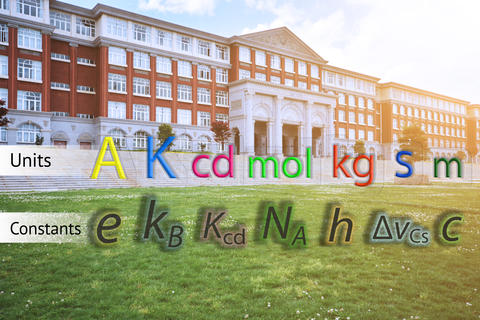
In 2018, the SI's seven base units (top row) are expected to be redefined in terms of invariant fundamental universal constants (bottom). A new publication will help high-school teachers communicate this change in the classroom.
Next year, scientists expect to change the way we define the basic units with which we measure our universe. An article by scientists at the National Institute of Standards and Technology (NIST) written for teachers will help ensure high school physics students are hip to the news.
The brief, six-page article, which appears in this month’s issue of The Physics Teacher, is designed to be a resource for teachers who are introducing the International System of Units (SI) into their classrooms. The SI, as the modern form of the metric system, has seven fundamental units, including the meter and the second. It is expected that in 2018, for the first time in history, all seven of these units will be defined in terms of fundamental constants of the universe such as the speed of light or the charge of a single electron. Only recently were all the relevant fundamental constants known with sufficient certainty to make such a redefinition possible, and the authors are eager to help students realize the change’s importance.
“It’s a historic moment,” said NIST physicist Peter Mohr, one of the article’s authors. “Back in the 19th century, James Clerk Maxwell—one of history’s great scientific visionaries—dreamed of a measurement system based on universal constants. Now that we are on the verge of realizing his dream, we want to explain why these constants have a relationship to SI units in a way high school students can understand.”
The article, written in everyday English, begins with a brief history of measurement units and shows how their limitations over past centuries have led to the need to redefine them. The kilogram, for example, is currently defined by a metal artifact, which has a mass that has apparently been changing over time. This prompted an international effort to redefine it in terms of electrical energy. Most of the article comprises brief summaries of each unit’s relation to universal constants, allowing teachers to show physics students these relationships right from the beginning of a course, when units are generally taught.
“One of the things that makes good sense for me is the unit of electrical charge,” said co-author Sandy Knotts, who recently retired after a career of teaching physics at Perkiomen Valley High School in Collegeville, Pennsylvania. “Now we can start out using the measurement of the electron rather than the ampere.”
At present, the ampere is defined in relation to the force between two parallel electrical wires of infinite length.
“That’s something that doesn’t exist in nature,” Knotts said. “Whereas an electron is an electron.”
Teaching the relationships this way is intended to help eliminate potential confusion in the early weeks of a physics course. The redefinition also has the advantage of allowing students (and scientists) to do work with a clear relationship to the universal constants.
“Defining the constants precisely provides a practical way to establish SI units,” Mohr said. “That allows you to do experiments and get answers in terms of these constants.”
This changeover in unit definitions may be the last one physics students will need to absorb for a long time, Mohr added.
“The definitions are such that they’re not dependent on technology,” he said. “We may come up with better ways to measure, but the definitions themselves won’t have to change.”
Paper: S. Knotts, P.J. Mohr and W.D. Phillips. An Introduction to the New SI. January 2017. The Physics Teacher, DOI: 10.1119/1.4972491

